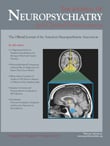Catatonia After Right Temporal Lobe Resection
To the Editor: Catatonia has been linked to perfusion abnormalities in the frontal, parietal, and temporal lobes and the basal ganglia. We describe a patient with no psychiatric history who developed catatonia after a right temporal lobectomy who was successfully treated with low-dose benzodiazepines.
Case Report
A 25-year-old African American man presented to the emergency room in a catatonic state. He had a history of an intractable seizure disorder since the age of four and a right temporal lobe resection about 4 years earlier after medication trials failed. Following the right temporal lobectomy, his grand mal seizures stopped. A few months later he developed recurrent episodes of immobility, mutism, refusal to eat or drink, negativism, and rigidity lasting for a week. He was started on Leviacetram for possible seizures. EEG studies during these episodes, including video EEG monitoring, did not reveal any seizure activity, and he was referred to the emergency room for suspicion of catatonia. He denied any prior psychiatric history, and there was no history of alcohol or illicit drug use. He was single, lived with family, had some learning difficulties, and was unemployed.
In the emergency room, he was immobile, lying on his bed with a “psychological pillow.” He was mute, with staring, negativism, and rigidity, and he refused to eat or drink. His catatonic symptoms rated a score of 15 on the Bush-Francis Catatonia Rating Scale. 1
He received lorazepam, 2 mg i.m., for his catatonia with some improvement in symptoms. A few minutes later, he was able to sit up on his bed and eat and drink; however, he continued to remain mute with significant psychomotor retardation and negativism. Vital signs and laboratory tests upon admission were within normal limits. A head CT scan revealed cerebellar atrophy and surgical clips, and volume loss consistent with a right temporal lobectomy was seen in the right temporal and frontal bones.
In the inpatient unit, the patient was mute, psychomotor retarded, and hypervigilant. He was started on lorazepam, 1 mg p.o. twice a day, and continued on Leviacetram, 500 mg p.o. twice a day. A day later, he was walking around and interacting briefly with staff and peers. Two days later, his catatonic symptoms resolved and he was discharged. Follow-up a few weeks later revealed that he did not have any catatonic symptoms.
Discussion
The advent of neuroimaging studies has helped identify neurological correlates to catatonia. 2 – 4 We describe a patient with no psychiatric history who developed recurrent catatonia after the resection of the right temporal lobe linking recurrent catatonia to the right temporal lobe.
While higher doses of benzodiazepines are needed for the treatment of catatonia, in our patient the catatonic symptoms essentially resolved on a low dose of lorazepam. This suggests that patients with brain damage may require lower doses of benzodiazepines for resolution of catatonic symptoms.
1. Bush G, Fink M, Petrides G, et al: Catatonia I: rating scale and standardized examination. Acta Psychiatr Scand 1996; 93:129–136Google Scholar
2. Kho KH, van Veelen NM, Beerepoot LJ, et al: A vanishing lesion in the temporal lobe associated with schizophrenialike psychosis and catatonia. Cogn Behav Neurol 2007; 20:232–234Google Scholar
3. Atre-Vaidya N: Significance of abnormal brain perfusion in catatonia: a case report. Neuropsychiatry Neuropsychol Behav Neurol 2000; 13:136–139Google Scholar
4. Northoff G, Kötter R, Baumgart F, et al: Orbitofrontal cortical dysfunction in akinetic catatonia: a functional magnetic resonance imaging study during negative emotional stimulation. Schizophr Bull 2004; 30:405–427Google Scholar



